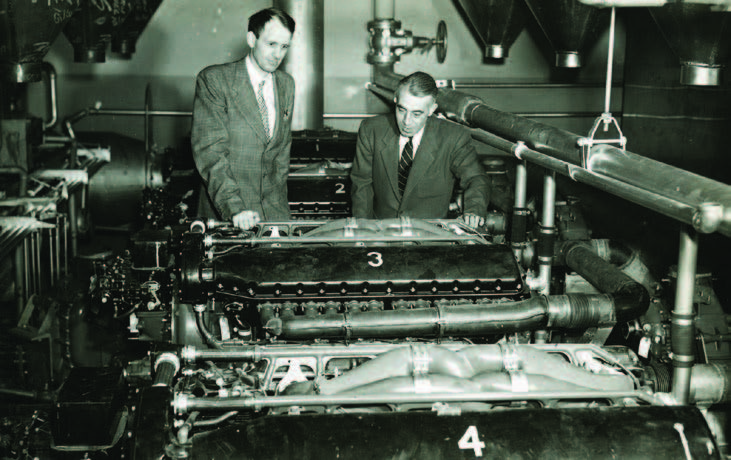
Like a rocket blast, the Aeronautics Department at Johns Hopkins was relatively short-lived but nonetheless spectacular.
Francis Clauser founded the department in 1946 at the behest of a faculty committee and university President Isaiah Bowman, who wanted a program geared toward graduate study and research. Clauser, now 93, still clearly recalls the Sunday afternoon in 1946 when Bowman called him at his home in California. Aeronautics Committee faculty had been captivated by a talk on supersonic flow that Clauser had presented months earlier at the Applied Physics Laboratory (APL). World War II had proven that aeronautics was going to play a major role in modern warfare and travel and Bowman and others wanted the burgeoning field studied at Johns Hopkins.
“I think the whole engineering world, as well as the general public, was fascinated by the German V-1 and V-2 missiles and the great effort on the part of the U.S. military to develop new missile systems and supersonic missions,” Clauser says today. “The aircraft industry at the time was involved in a number of missiles projects, as were APL and [the Jet Propulsion Laboratory]. And aeronautics departments were cropping up at other schools, such as Cornell, NYU , and Michigan. So, establishing a department like this seemed a great opportunity for students.”
Clauser, a pioneer in the aeronautics field who would chair the department throughout its existence at Hopkins, previously worked for Douglas Aircraft Company, where he was a research aerodynamicist and flight tester. In 1945, he helped design the first communications satellite.
During the department’s first year, Clauser worked quickly to organize the department and hire faculty, notably Guy L. Bryan and Stanley Corrsin. Housed in the new Aeronautics Building (which later became Merryman Hall), the department from its inception worked closely with research institutions and government labs such as APL, the Aberdeen Proving Ground, and the Naval Ordnance Laboratory, with personnel from these labs giving specialized courses to students.
Navy funding made possible the construction of a supersonic wind tunnel, which took three years to build and was completed in 1951. The department used the wind tunnel, located in the basement of the Aeronautics Building, to conduct experiments on turbulence and friction at subsonic and supersonic speeds—up to twice the speed of sound.
Four large aircraft engines powered the tunnel’s blowers that propelled air into a room where probes were placed to study flow. Mufflers were placed on the aircraft engines to reduce the noise, says Clauser. “We were all worried we’d upset the neighbors.”
In 1950, the department appointed Leslie G. Kovasznay, a renowned expert in turbulence, to the faculty. Other notable hires under Clauser’s tenure were research scientists Mark Morkovin and Robert Betchov. Throughout the 1950s, the department’s examination of fluid mechanics and supersonic flow laid the groundwork for understanding what happened when missiles or airplanes go supersonic, and formed the basic principles that would affect aircraft design and flight at and below the speed of sound.
The Aeronautics Department had a seminar every week, typically on Saturday mornings, to allow distinguished scientists and researchers from outside Hopkins to present their ideas. In the January 2003 edition of the Annual Review of Fluid Mechanics, John Lumley, a former graduate student in the department and now the Willis H. Carrier Professor of Engineering Emeritus at Cornell, noted that the seminars usually ended with a barrage of piercing questions.
“I saw many speakers reduced to impotent rage, their seminars brought to a premature end. I am probably exaggerating, recalling the worst cases,” he wrote in an article about Stanley Corrsin. “I am sure Stan and the others felt that they were setting an example for the students, teaching them not to accept claptrap gladly.”
Recalls Clauser, “We told [the speakers] ahead of time what it would be like; they knew of our reputation and what they were getting into. Most of them enjoyed it very much and after the talk the whole group of us would all go to lunch at the faculty club.”
Department faculty starred on a number of episodes of the TV series The Johns Hopkins Science Review, including “Flight at Supersonic Speeds,” which aired in February 1949, and a three-program series, Man Will Conquer Space, which aired in October 1952. The last of these three shows featured guest Wernher von Braun, a leading figure in the development of rocket technology.
In order to advance Hopkins’ program in mechanics, the chairmen of the departments of Aeronautics, Civil Engineering, and Mechanical Engineering jointly proposed at an advisory board meeting on May 3, 1960, that the three departments merge to form the Department of Experimental and Theoretical Mechanics. The advisory board unanimously passed the motion, adopting the name Department of Mechanics. The Aeronautics Department officially disbanded later that year.
Clauser, who left Johns Hopkins in 1965 to start the School of Engineering at the University of California, Santa Cruz and serve as its vice chancellor, said that his time at Hopkins was happy and the decision to form the Department of Mechanics was wise.
“Was I sad? A little,” he says, “but I thought it was the right thing to do.”




